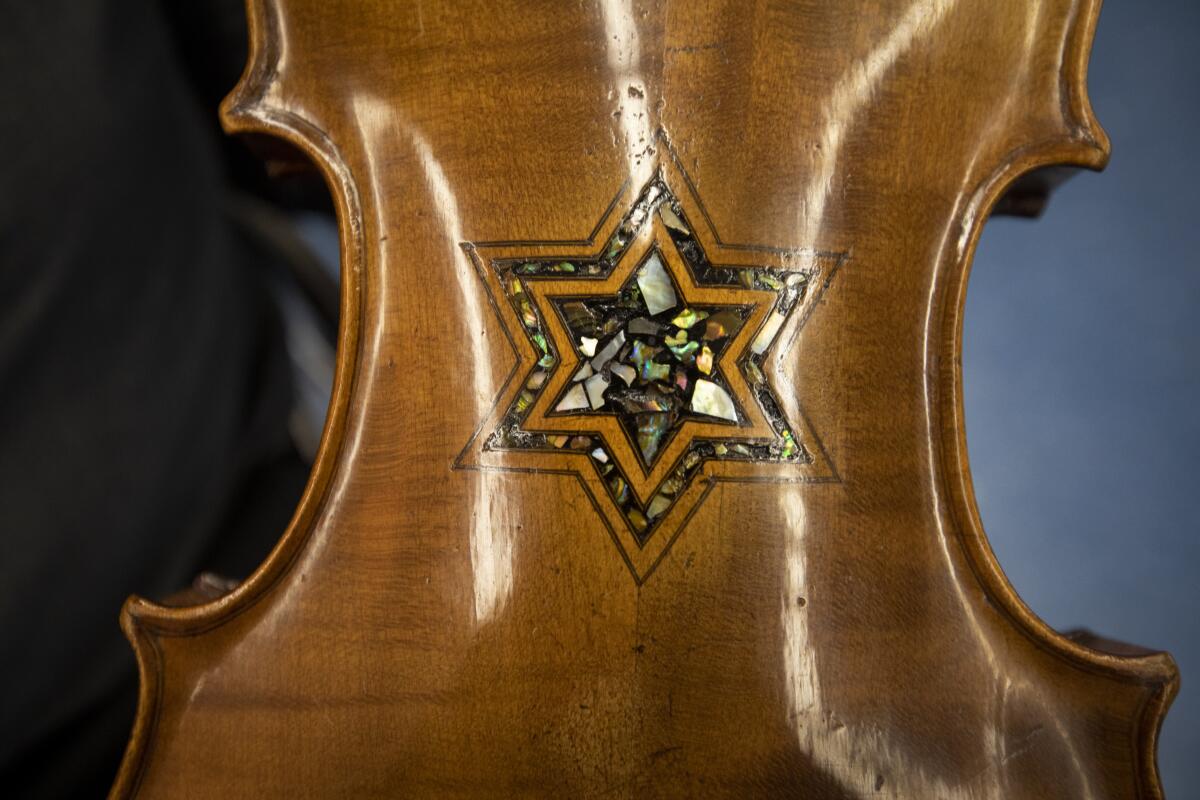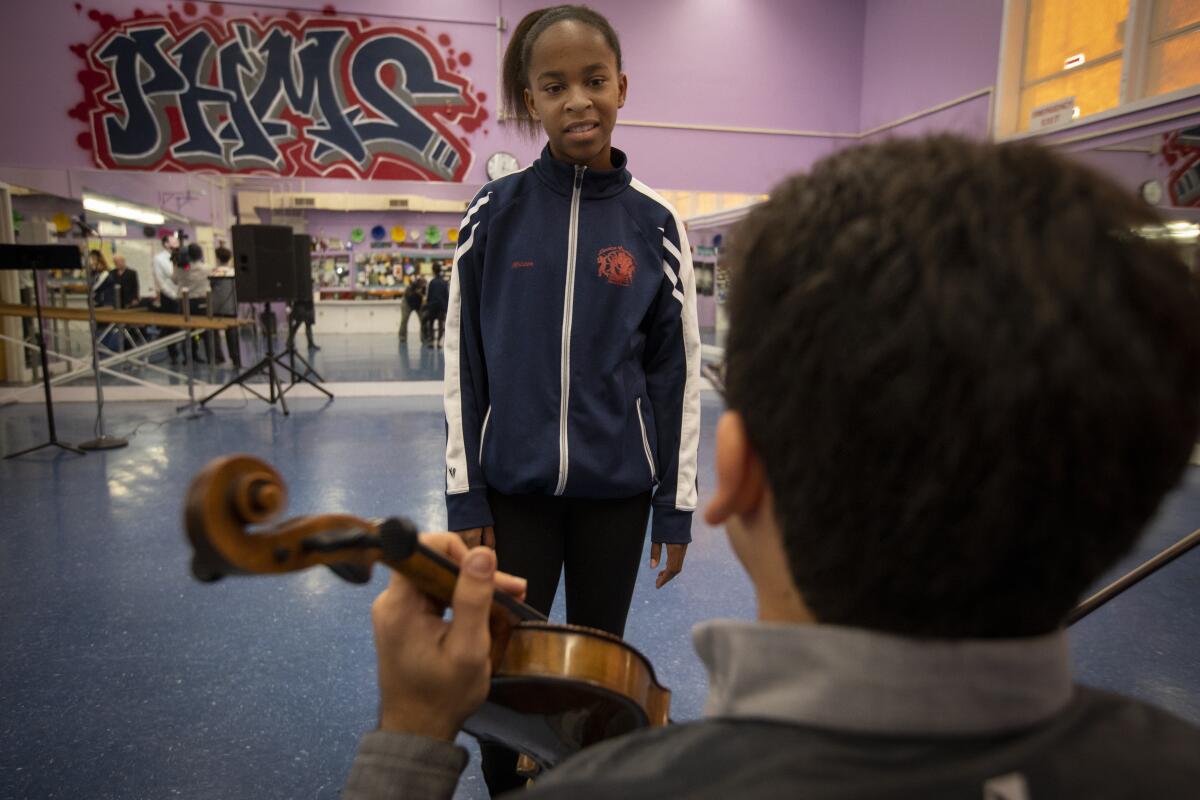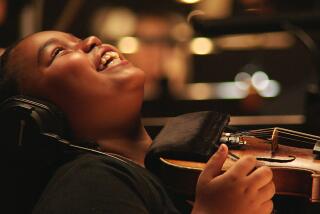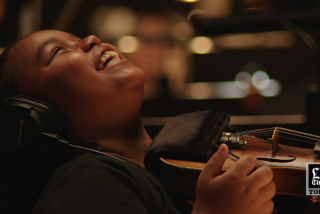These violins survived the Holocaust. COVID-19 sent them back into hiding

Joan-Kristen Gray sat on the scuffed floor of the dance studio, squeezed tightly between her classmates, watching intently as fellow eighth-grader Sasha Arzhelik improvised a hip-hop dance to the plaintive sounds of guest artist Niv Ashkenazi playing an antique violin. It was late November of last year at Patrick Henry Middle School in Granada Hills, and Joan-Kristen was experiencing the benefits of pre-pandemic life: in-person arts education, live music and dance, and socialization without distance.
The lesson that day didn’t involve learning a new dance routine or perfecting form. Instead, the class witnessed a presentation of the Violins of Hope, a collection of stringed instruments that survived the Holocaust and were later restored by Israeli violin-makers Amnon and Avshalom Weinstein.
For the record:
10:33 p.m. Sept. 28, 2020In an earlier version of this article, photos taken inside the Soraya in Northridge were credited to Luis Luque. They should have been credited to Ricki Quinn/The Soraya.
Joan-Kristen’s class erupted in applause at the end of the Violins of Hope presentation. “Thank you Sasha and Niv, that dance was beautiful,” said Anthony Cantrell, the director of arts education at the Younes and Soraya Nazarian Center for the Performing Arts at Cal State Northridge. “And the best part is, you are all invited to the Soraya in March to see Niv and others play a full concert on these special instruments. We can’t wait to see you again then.”
Brought to Southern California by the Soraya and other partnering organizations, the violins were supposed to have appeared in concerts with the Los Angeles Jewish Symphony, Rotterdam Philharmonic and Jerusalem Quartet in late March and early April this year. Like so many musical events, those concerts never happened. As COVID-19 swept across the United States, the performances were first postponed, then eventually canceled.
“We no longer felt it reasonable or responsible to keep our furloughed staff waiting in limbo any longer,” says the company, which is laying off 91.
“The message these violins carry with them is suddenly tenfold important,” Soraya Executive Director Thor Steingraber said in March, just days after dozens of the historic violins arrived at the venue. “That’s why making the decision [to cancel] these concerts — while it was clearly the right thing to do — was so heartbreaking.”
Ashkenazi, a Los Angeles native who studied with Itzhak Perlman at Juilliard, said one of the main reasons he is a Violin of Hope ambassador is that the instruments provide a voice for the voiceless.
“We do have many testimonies from survivors, which is so important, and we must keep those stories alive,” the violinist said. “But there are millions more who didn’t survive. We don’t know their exact stories. To me this represents those people. One of the main tenets of Violins of Hope is allowing silenced voices to be heard again.”
Many of the instruments in the Violins of Hope collection made their way to the Weinstein violin shop in Tel Aviv via refugees after World War II. Before the war, they were the prized possessions of klezmer musicians, orchestra members and wealthy Jewish families. After the war, many of the instruments represented all that was left of a family’s legacy. Some had survived Nazi concentration camps, where their owners were forced to play for Nazi officers during parties or to perform for prisoners as they were marched to death chambers.
Many of the violins were handcrafted in early 20th-century Germany and feature exquisite carvings of the Star of the David. Beautiful to hear played or just to admire visually, they were scheduled to go on exhibit at the Holocaust Museum Los Angeles, formerly Los Angeles Museum of the Holocaust, following the Soraya concerts.
Instead, like so many travelers, the Violins of Hope found themselves in limbo and were forced to quarantine. With the concerts initially postponed, the Soraya needed a safe place to store the invaluable instruments. And so, instead of being performed on and displayed, the violins were packed up and placed underneath the Soraya’s main stage. They remained there until last week, hiding in secrecy, protected from theft or vandalism.
Now, as the pandemic continues with no clear end in sight, the violins have been flown back to Tel Aviv. Last week, before they were packed up for the journey home, Ashkenazi and two other violinists, Janice Markham and Lindsay Deutsch, had a brief chance to play the priceless instruments at the Soraya. There was no audience in the 1,700-seat hall, but the violins’ voices were heard nevertheless.
That audience-less “concert” proved a poignant and disappointing end to a year-long educational and community initiative by the Soraya.
“The fact that 60 Holocaust violins, handcrafted in early 20th century Europe, [spent months in] hiding on our campus in Los Angeles this year, I think about it all the time,” Steingraber said. “It’s just so unlikely, and so heartbreaking.”
While Joan-Kristen and so many other students and community members lost the opportunity to hear the Violins of Hope in concert this year, Steingraber hopes that at some point the violins will make their way back to Southern California. For now, though, the Soraya team is finding solace in the fact that before the pandemic hit, they were able to take one of the violins to more than 40 area schools.


At the end of the Patrick Henry Middle School presentation last November, Joan-Kristen rushed up to Ashkenazi to ask him questions about the violin he played and get a closer look at the abalone shell Star of David inlaid on its back.
“I know this sounds obvious,” she said, “but I didn’t really know that the Nazis killed that many people. Of course I knew they were after us Black people, but I’d never learned so much about Jewish people and the Holocaust before today. Like, why would you hate someone just because of their beliefs about God?”
Watching her classmate dance while Ashkenazi played violin “really opened my eyes,” Joan-Kristen said, explaining how the Violins of Hope helped her understand the importance of stamping out hateful ideologies before they spread. “It’s not like reading about it in a history book,” she said. “The violin told a real story that really happened.”
A first look at Frank Gehry’s Colburn School concert halls and plaza, which are key to making Grand Avenue in DTLA the nation’s premier arts district.
More to Read
The biggest entertainment stories
Get our big stories about Hollywood, film, television, music, arts, culture and more right in your inbox as soon as they publish.
You may occasionally receive promotional content from the Los Angeles Times.







